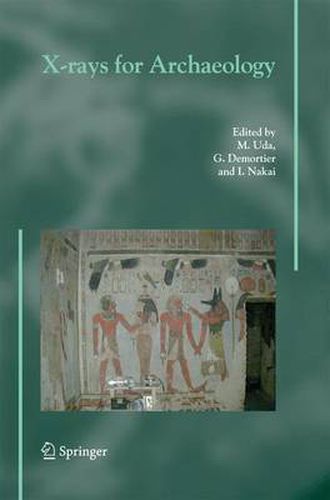Readings Newsletter
Become a Readings Member to make your shopping experience even easier.
Sign in or sign up for free!
You’re not far away from qualifying for FREE standard shipping within Australia
You’ve qualified for FREE standard shipping within Australia
The cart is loading…






This title is printed to order. This book may have been self-published. If so, we cannot guarantee the quality of the content. In the main most books will have gone through the editing process however some may not. We therefore suggest that you be aware of this before ordering this book. If in doubt check either the author or publisher’s details as we are unable to accept any returns unless they are faulty. Please contact us if you have any questions.
The application of X-rays to objects of archaeology and the attempt to gain insight into both construction and chemical composition in a non-destructive manner date back to the days of the discovery of radiation. Nowadays, X-ray techniques, such as X-ray fluorescence and diffraction are standard tools.
The book contains scientific data, i.e. in situ measurement data taken with portable XRF and XRD, and fine data taken with accelerating ion beams and synchrotron radiations, and with their explanation. Results obtained by traditional scientific methods are also reviewed. The book contains experimental data taken both from monuments in the field and exhibits in museums, i.e. ancient Egyptian wall painting pigments, ancient Egyptian wooden statues, ancient Egyptian mummies, ancient Greek funerary monuments, Cypriot ceramics, Medieval, Lyubliana and Venetian glass, Romanian ceramics, ancient Near East clay, old Japanese porcelain, pre-Hispanic items from ancient America, ancient Chinese underglaze-red, blue and white porcelain, Chinese celadon, Phoenician cosmetics, glazes, ancient gold and silver coins, gold jewelleries, gold alloys, corroded metals, gemstones (ruby, emerald and garnet), painting pigments, pottery, bronze, obsidian, stucco, turquoise, and so on. This discussion between natural scientists and archaeologists predicts the future direction of archaeology.
$9.00 standard shipping within Australia
FREE standard shipping within Australia for orders over $100.00
Express & International shipping calculated at checkout
This title is printed to order. This book may have been self-published. If so, we cannot guarantee the quality of the content. In the main most books will have gone through the editing process however some may not. We therefore suggest that you be aware of this before ordering this book. If in doubt check either the author or publisher’s details as we are unable to accept any returns unless they are faulty. Please contact us if you have any questions.
The application of X-rays to objects of archaeology and the attempt to gain insight into both construction and chemical composition in a non-destructive manner date back to the days of the discovery of radiation. Nowadays, X-ray techniques, such as X-ray fluorescence and diffraction are standard tools.
The book contains scientific data, i.e. in situ measurement data taken with portable XRF and XRD, and fine data taken with accelerating ion beams and synchrotron radiations, and with their explanation. Results obtained by traditional scientific methods are also reviewed. The book contains experimental data taken both from monuments in the field and exhibits in museums, i.e. ancient Egyptian wall painting pigments, ancient Egyptian wooden statues, ancient Egyptian mummies, ancient Greek funerary monuments, Cypriot ceramics, Medieval, Lyubliana and Venetian glass, Romanian ceramics, ancient Near East clay, old Japanese porcelain, pre-Hispanic items from ancient America, ancient Chinese underglaze-red, blue and white porcelain, Chinese celadon, Phoenician cosmetics, glazes, ancient gold and silver coins, gold jewelleries, gold alloys, corroded metals, gemstones (ruby, emerald and garnet), painting pigments, pottery, bronze, obsidian, stucco, turquoise, and so on. This discussion between natural scientists and archaeologists predicts the future direction of archaeology.